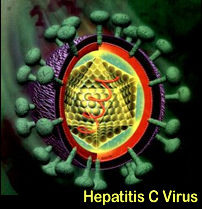Pre-treatment
with Ribavirin Improves Response to Interferon-based Therapy for Hepatitis
C
 |
 |
 |
 |
 |
|
| SUMMARY:
Ribavirin "priming" -- or starting ribavirin monotherapy
before adding pegylated interferon -- was associated with
a small but significant improvement in sustained virological
response in patients with chronic hepatitis C virus (HCV)
infection, according to a German study presented at the recent
American Association for the Study of Liver Diseases "Liver
Meeting" (AASLD 2010) in Boston.
|
|
|
 |
 |
 |
 |
By
Liz Highleyman
 B.
Fueloep and colleagues retrospectively analyzed the effect of ribavirin
monotherapy followed by standard combination therapy (pegylated
interferon plus ribavirin) on initial decline in HCV viral load
and overall treatment outcomes.
B.
Fueloep and colleagues retrospectively analyzed the effect of ribavirin
monotherapy followed by standard combination therapy (pegylated
interferon plus ribavirin) on initial decline in HCV viral load
and overall treatment outcomes.
Addition
of ribavirin reduces the risk of relapse after completing treatment,
and therefore increases the likelihood of sustained
virological response (SVR) to interferon-based therapy. Ribavirin
is a weak inhibitor of the HCV NS5B RNA polymerase in vitro, but its
mechanism of action is not fully understood.
This analysis
included 93 chronic hepatitis C patients from 5 centers in Germany.
Just over half were men and 78% had hard-to-treat HCV genotype 1. Within
this group, 43 were treatment-naive, 28 were prior relapsers, and 19
were prior non-responders.
All participants
were initially treated with ribavirin monotherapy, at an average dose
of 15.2 mg/kg, for an average duration of 39 days. They then added pegylated
interferon and continued for the usual standard duration of therapy.
Results
 |
The
average decline in HCV RNA during the ribavirin monotherapy period
was 0.56 log. |
 |
Changes
were variable, however, ranging from +1.07 to -1.76 log. |
 |
Viral
load changes varied according to prior treatment status: |
| |
 |
Prior
relapsers: mean 0.67 log decline; |
 |
Treatment-naive:
mean 0.48 log decline; |
 |
Prior
non-responders: mean 0.28 log decline. |
|
 |
Patients
with HCV genotype 3 showed the greatest viral load decline (0.95
log), followed by those with genotype 4 (0.6 log). |
 |
Platelet
counts increased by an average of 24 mcl (range 9-49 mcl) during
ribavirin priming. |
 |
ALT
levels decreased by a mean 17 IU/mL (range 4-31 IU/mL) during the
priming period. |
 |
Hemoglobin
decline during ribavirin monotherapy -- an indicator of anemia --
was not associated with initial viral kinetics. |
 |
6
prior non-responders experienced larger and faster viral load decline
after ribavirin priming compared with their previous treatment: |
| |
 |
Week
4: 2.0 log after priming vs 1.2 log during first treatment; |
 |
Week
12: 3.6 vs 2.0 log, respectively; |
 |
Week
24: 6.0 vs 5.4 log, respectively. |
|
 |
At
the time of abstract submission, 26 previously treated patients
had undergone 6 months of post-treatment follow-up. |
 |
Within
this group, 12 prior relapsers (44%) and 2 prior non-responders
(36%) achieved sustained virological response. |
"[R]ibavirin
monotherapy induces a mild but significant decline in hepatitis C viremia,"
the investigators concluded. "The highest HCV RNA log10 decline
after ribavirin priming occurs in patients with prior relapse and genotype
3."
Investigator affiliations: Gastroenterology and Hepatology, University
Leipzig, Leipzig, Germany; Gastroenterology and Hepatology, Charite,
Berlin, Germany; Gastroenterology and Hepatology, J.W. Goethe University,
Frankfurt, Germany; Hepatology, IFI Institute for Interdisciplinery
Medicine, Hamburg, Germany; Gastroenterology, Marienhospital Hamm, Hamm,
Germany.
12/14/10
Reference
B
Fueloep, P Rohde, P Buggisch, and others. The antiviral efficacy of
ribavirin priming. A follow up of 93 patients treated with ribavirin
monotherapy followed by standard combination treatment. 61st Annual
Meeting of the American Association for the Study of Liver Diseases
(AASLD 2010). Boston, October 29-November 2, 2010. Abstract
980.